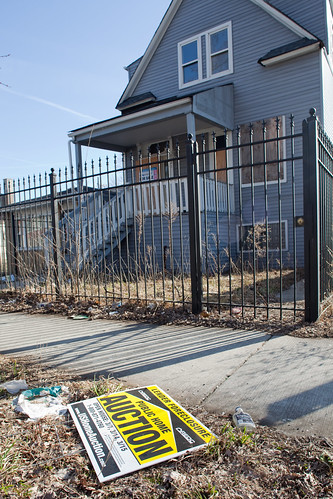BofA executive Jack Schakett made some interesting comments earlier today:
"There is a huge incentive for customers to walk away because getting free rent and waiting out foreclosure can be very appealing to customers."Schakett noted that the foreclosure process is currently taking 13 to 14 months ...
For many the timeframe is apparently much longer. On Monday David Streitfeld wrote in the NY Times: Owners Stop Paying Mortgages, and Stop Fretting
The average borrower in foreclosure has been delinquent for 438 days before actually being evicted, up from 251 days in January 2008, according to LPS Applied Analytics.These long foreclosure time lines can have a significant adverse impact on housing.
...
More than 650,000 households had not paid in 18 months, LPS calculated earlier this year. With 19 percent of those homes, the lender had not even begun to take action to repossess the property ...
Housing economist Tom Lawler alerted me to a 2008 research paper by Freddie Mac economists Amy Crews Cutts and William A. Merrill: Interventions in Mortgage Default: Policies and Practices to Prevent Home Loss and Lower Costs. They studied the foreclosure time lines and costs in several states and found that 270 days is sufficient time to allow the borrower to cure, and any more time actually incentivizes the borrower to strategically default:
There are many challenges that policy makers, investors, servicers and borrowers face in minimizing the incidence of home loss through foreclosure. Among them is the tension between too little time in the foreclosure process, such that some borrowers are unable to recover from relatively mild setbacks before they lose the home but investors minimize pre-foreclosure time related costs, and too much time in the foreclosure process, such that the borrower is incented to let the home go to foreclosure sale during which no mortgage payments are made (in essence, free rent for a significant time) and investor costs rise rapidly.One of unintended consequences of the government foreclosure delaying strategy (probably aimed at limiting supply and supporting house prices), is that strategic defaults have gained fairly widespread acceptance. And that means the eventual cost to the taxpayer will be higher than if the lenders had either modified the loans, or foreclosed, or approved a short sale, within about 270 days.
...
A sweet spot for the optimal time in foreclosure likely exists around a statutory timeline of 120 days (the current national median, and equivalent to 270 days after adding in 150 days for pre-referral loss mitigation activities by servicers through workouts) in which the borrower’s incentives are aligned with both a high probability of curing out of the foreclosure and keeping the pre-foreclosure costs to the investor contained.
Foreclosure Mediation Programs Succeed Across The Country — Will Pawlenty Give Minnesota’s A Chance?
Today, across the country, mortgage mediation programs aimed at helping struggling homeowners stay in their homes are getting underway. Programs are launching in Maryland, as well as Florida’s 6th and 10th judicial circuits — encompassing Pasco, Pinellas, Hardee, Highlands, and Polk counties — while Cook County, Illinois is beginning a huge round of outreach for its burgeoning program.
In all, “the number of jurisdictions with foreclosure mediation programs is nearly double the number a year ago, with jurisdictions in 21 states now offering foreclosure mediation or negotiation programs.” Not on this list, however, is Minnesota, where Gov. Tim Pawlenty (R) saw fit to veto a program last year.
The Minnesota state senate recently passed the bill again, sending it to the state House, so Pawlenty could very well get a second shot soon. And there’s simply no reason for him to oppose the program, as mediation — during which a bank meets face-to-face with a borrower, often in the presence of a judge and housing advocates, to try and forge a mortgage modification or other arrangement that prevents a foreclosure — is one of the most successful methods of helping struggling borrowers stay in their homes.
Connecticut’s mediation program, for instance, has kept 60 percent of its borrowers out of foreclosure. Philadelphia’s success rate is also 60 percent, while Nevada claims an 85 percent success rate:
About 80 percent of homeowners at risk of losing their homes don’t engage in any efforts to negotiate with their lender. And those who do so on their own often run into a bureaucratic mess, including hours on hold, lost records, and customer service representatives who know nothing about the borrower’s situation. Mediation helps to ensure that situations like that don’t happen.
“These new protections empower our fellow Marylanders, putting them on a more equal footing with mortgage companies that too often can’t be bothered to pick up the phone before beginning a foreclosure proceeding against a Maryland family,” said Governor Martin O’Malley (D). And lest Pawlenty think this is a purely partisan issue, it has also won the praise of Gov. Jodi Rell (R-CT). “Clearly, mediation is an effective tool homeowners can use to ward off foreclosure,” she said. “This program is a beacon of hope for hard-pressed homeowners and a real alternative for lenders.”
In mediation, there’s no requirement for a lender to accommodate a borrower, but it’s often the case that preventing a foreclosure is in the best financial interest of both the borrower and the lender. As CAP’s Andrew Jakabovics and Alon Cohen wrote, “the simple act of participating in mediation consistently yields solutions short of foreclosure that are acceptable to both sides.” Hopefully, should the Minnesota legislature do the right thing and create a program, Pawlenty will allow it to stand.
penis enlargement products

No comments:
Post a Comment